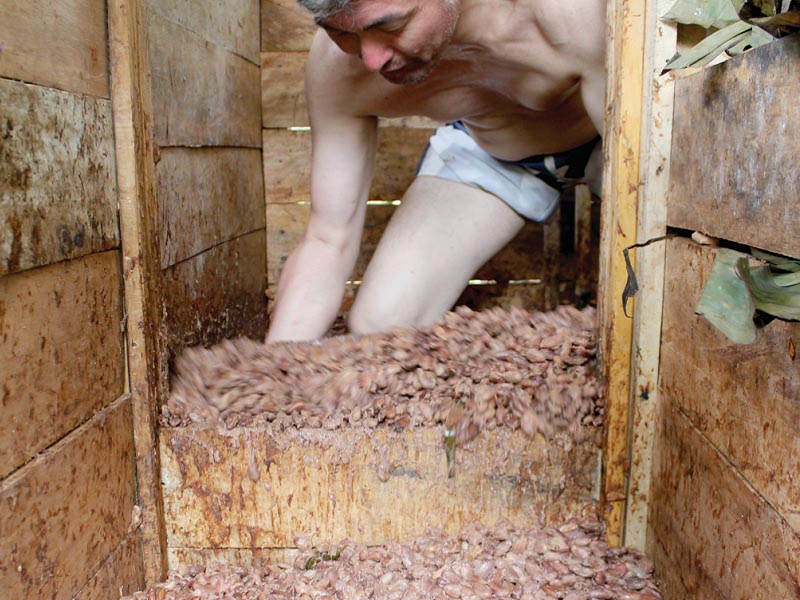Chocolate: The Art Of Fermentation, Bringing Out The “Terroir” Of A Primitive Island
by Kyoko Nakamura
@ 09 Mar 2018

Fermentation is a classic technique used to make many things like cheese and wine, but do you know that chocolate too, is fermented food?
Chef Kazutoshi Narita was awarded Asia’s best pastry chef in 2017. He was chief pâtissier at three Michelin-starred restaurants, such as Enoteca Pincchiori in Italy and Le Château de Joël Robuchon in Tokyo. Now that he’s settled in Tokyo, he is taking care of several restaurants’ pastry sections, including two-Michelin-starred French restaurant,
Esquisse. Throughout these brilliant restaurants, he has been using the world’s finest produces, including chocolate; his favourite was “Chuao” from Venezuela, one of the most precious and expensive chocolate in the world. He then started making chocolate the original way.
To fnd the ‘original’ taste, he thought he needs to explore the origin of the modern world – the primitive world. He talked about this idea with his vanilla supplier,
Kazunori Oze who has been working in Papua New Guinea for more than ten years, because he loves the people there and would like to help them. Oze told Chef Narita that Papua New Guinea still is very primitive in nature and there is a cacao producing area in the Manus province. With the help of Oze, he visited the Manus province in 2015 and taught the farmers there how to ferment the cacao beans. In May
2017 was his second journey to Papua New Guinea. He was invited by Rapatona – the local level government in Manus and visited a small
island called Rambutyo, together with Kanah Pouru, researcher of Cocoa & Coconut Research Institute (CCI) established by the Papua New
Guinea government.
Chef Narita displayed how to mix the cacao beans to incorporate oxygen and process the fermentation consistently. “To mix the 600kg of the cacao beans every day for a week is really tough, but it would make a difference,” he explained to the people. “Nowadays, many people adore Criollo because it is very precious. But, it is absolutely nonsensical to just buy something based on its label. I had been using fnest Criollo grown in Chuao for a long tme. So, I know the aroma, favour and character very well. The cacao beans from Rambutyo are Trinitallio: a hybrid species of Criollo and Forastero, but after the fermentaton, I think the volume of aroma and favour of the cacao beans from Rambutyo is the same as Chuao, and I personally believe that they have a better taste.”

“With my fermentation technique, I’m making chocolate which has the Criollo aroma and favour with high polyphenol content. Using the cacao beans from an untouched island and fermenting with native bacteria which have survived from ancient tmes in clean, primitive nature. I would like to bring out the ‘terroir’ of this island.” With these Papua New Guinea cacao beans, Chef Narita made bonbons and sent them to a chocolate competition: Club des Croqueurs de Chocolat (CCC) in Paris. The result will be announced in October, at Salon du Chocolat, Paris. “This is what I believe as original and it will be appreciated as ‘classic’ in the future,” says Chef Narita.
Adapted from the
Jul Aug 17 issue of Cuisine & Wine Asia.
 Fermentation is a classic technique used to make many things like cheese and wine, but do you know that chocolate too, is fermented food? Chef Kazutoshi Narita was awarded Asia’s best pastry chef in 2017. He was chief pâtissier at three Michelin-starred restaurants, such as Enoteca Pincchiori in Italy and Le Château de Joël Robuchon in Tokyo. Now that he’s settled in Tokyo, he is taking care of several restaurants’ pastry sections, including two-Michelin-starred French restaurant, Esquisse. Throughout these brilliant restaurants, he has been using the world’s finest produces, including chocolate; his favourite was “Chuao” from Venezuela, one of the most precious and expensive chocolate in the world. He then started making chocolate the original way.
Fermentation is a classic technique used to make many things like cheese and wine, but do you know that chocolate too, is fermented food? Chef Kazutoshi Narita was awarded Asia’s best pastry chef in 2017. He was chief pâtissier at three Michelin-starred restaurants, such as Enoteca Pincchiori in Italy and Le Château de Joël Robuchon in Tokyo. Now that he’s settled in Tokyo, he is taking care of several restaurants’ pastry sections, including two-Michelin-starred French restaurant, Esquisse. Throughout these brilliant restaurants, he has been using the world’s finest produces, including chocolate; his favourite was “Chuao” from Venezuela, one of the most precious and expensive chocolate in the world. He then started making chocolate the original way.

